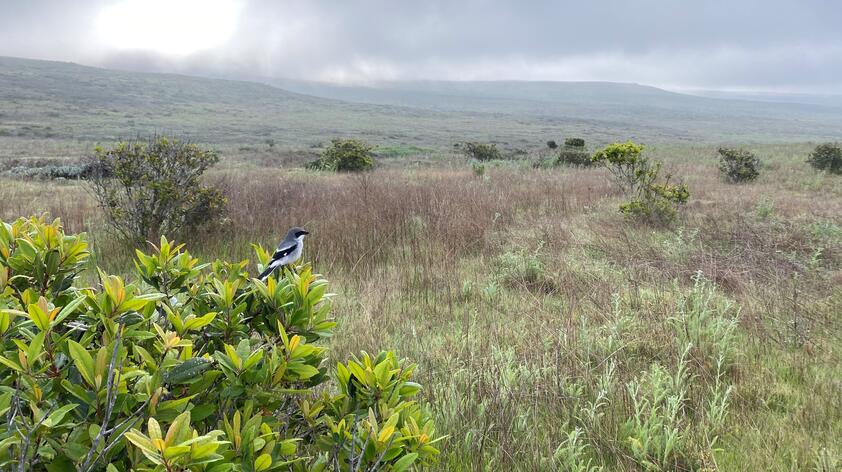
Do shrikes dream of raptor feet?
Sixty-five miles off the coast of San Diego, on a small U.S. Navy-owned island, lives a fierce, tiny, and unusual bird. Despite its small size and dainty feet, the San Clemente Loggerhead Shrike is often referred to as “the butcher bird.”
This unique predatory songbird excels at hunting mice, lizards, small birds, and a variety of insects. Weighing around 50g – just heavier than a golf ball – shrikes can be seen carrying mice half their weight from the ground up to nearby shrubs where they impale their prey.
Endemic to San Clemente Island, the San Clemente Loggerhead Shrike was once the most endangered songbird in the continental United States with a population low of fourteen individuals. For over twenty years, San Diego Zoo Global (SDZG) has been collaborating with the U.S. Navy and other teams of biologists to recover this critically endangered subspecies of shrike. A team of zoo biologists manages the conservation breeding aspect of the shrike’s population recovery and the breeding flock of about 60 birds housed on the island. The primary goal of the breeding program is to produce individuals, mainly juveniles, for reintroduction to augment the in-situ island population.
We strive to provide these young shrikes with extensive opportunities to hone the skills necessary for survival upon their reintroduction.
The breeding flock of shrikes receives live prey daily. The opportunity to hunt and kill their food is an enriching experience for the flock and helps sharpen the juveniles’ techniques, allowing them to hunt successfully on their own once reintroduced. When I moved to the island and joined the SDZG crew, I found myself waking up each morning to a macabre scene. Entering the shrikes’ habitat for daily feeding and checks, I often find myself navigating under and around various branches adorned with the skewered bodies of their prey. These stored treasures are both fascinating and appalling to witness. Sometimes it’s a cricket impaled on a thorn, a mouse head mounted or wedged into the fork of a perch, and often a few tailless lizards hanging overhead. This gruesome food storage method, called caching, has several important purposes.
Shrikes do not come equipped with the same tools for consuming prey that most other carnivorous birds possess. Shrike feet lack the raptorial strength that an eagle or hawk has to hold down prey, while powerful beaks tear into tendons and bone. Instead, shrikes use forked or pointed branches to hold their prey for them so that they can pull apart their intended meal into manageable pieces with their small, hooked beaks. While this may seem grisly, the shrike’s prey usually meets a quick demise and is generally already deceased upon impalement. Impaled prey is not usually consumed in their entirety right away, and the leftovers are left around each shrike’s territory. These caches function as a method of food storage and as markers to announce and define the bird’s territory.
Shrikes are sit-and-wait predators, positioning themselves at high vantage points and darting down to the ground when prey scampers into view. With larger prey items such as lizards and mice, shrikes typically will execute a series of bites to the neck before grabbing and shaking their prey, allowing the prey’s body weight to snap the vertebra and finish them off. The breeding flock’s live prey is placed in feeding corrals to allow space for these hunting behaviors to occur without the risk of the birds losing a meal. While the shrikes under SDZG’s care are superb hunters, adept at catching and caching their daily live mice and insects, it is important that the juvenile shrikes slated for reintroduction are given more challenging hunting scenarios before they are placed in their native habitat.
In order to increase difficulty and better mimic a natural hunting environment, we add native vegetation to their feeding corrals for prey to hide in. Pre-reintroduction shrikes are also given lizards and insects in foraging boxes, which are added to their environment separately from the corrals containing live mice. Much like feeding corrals, these open-faced boxes provide a risk-free space for hunting with changeable substrate such as rocks, dirt, and grasses to simulate the variety of terrain our young shrikes will encounter on San Clemente Island.
To supplement our pre-reintroduction shrikes with native food items, crewmembers opportunistically partake in some hunting of our own while going about our day. It is not uncommon to see one or two of my team stalking a lizard just after lunch, or peering into a clump of grass with a bug container in hand because there is a “fun looking insect in there that the shrikes might like.” We are dedicated to our birds and are always investigating ways to improve our techniques to enhance the success of individuals reintroduced on the island.
Most recently, we are in the process of developing a predator aversion program for our juveniles. Preparing young shrikes to recognize the hazards of predators, such as peregrine falcons and island foxes, will further benefit their survival in their native habitat.
It was once common to encounter shrikes flying about on San Clemente Island – now it is a much more special and rare sight to see. Whenever I find a shrike that I haven’t seen before, there is no better feeling than squinting at its leg bands, writing them down, running to the office to check our records, and finding that it was one of ours. It is incredibly rewarding knowing that the shrikes we have cared for are out there on the island’s wild and rugged slopes, thriving and contributing to the continuation of their species.













